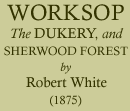< Previous | Contents | Next >
Hamlets in the parish of Worksop
Ratcliffe, Sloswicks and Kilton
Ratcliffe.
This, too, is a hamlet of Worksop, situated about two miles to the west of the town, beyond the Worksop Manor House. There is nothing memorable about its history. At the time of Harrison’s survey it was let in several farms, some of the fields towards the west chiefly, are spoken of as bounded by the lands of Gilbert Smith, and on the north by those of John Snowden. It seems probable that these latter constituted the estate of what is now called Harness Grove, which, however, is not mentioned by that name in the survey. At this latter place is a genteel residence of considerable antiquity, which has been recently enlarged. It is now the residence of Henry S. Hodding, Esq. Separated from Harness Grove by the turnpike road to Chesterfield is Darfolds, an ancient farm on the Manor estate. Its name would seem to imply that it was a deer or cattle fold of the Lord of the Manor. In the orchard of the farmhouse is a well of fine water, which formerly supplied Worksop Manor House, the water having been conveyed thither by leaden pipes, which were removed when the principal part of that mansion was pulled down.
Sloswicks.
In the grant of Richard de Lovetot "of the mill of Manton, &c.," it is added, also, "the whole of Sloswick." This is another hamlet, far distant on the west side of the town, near Welbeck. The name of this place again suggests an early settlement from Daneland, the first residents having transferred to this place a designation from their native country.
Nothing is known of the intermediate history of this place till the 27 of Queen Elizabeth, who, among other things, granted it to Roger Manners and his heirs. Roger Manners was a son of Sir John Manners, a younger son of the house of Belvoir, who by his runaway marriage with Dorothy, the co-heiress of Sir George Vernon, of Haddon Hall, inherited that noble estate, and who also, on failure of the elder branch, became ancestor of the Dukes of Rutland. Roger Manners resided at the Hall at Whitwell, and was buried in the north transept of that church, where his monument still remains, with a quaint, laudatory inscription. Sloswick afterwards became the property of the Dukes of Portland, and was exchanged by them for other property with the Duke of Norfolk. It thus became part of the Worksop Manor estate, with which it passed by purchase to the Duke of Newcastle.
Kilton.
Kilton, again, is another hamlet of Worksop, situated about a mile distant to the north-east of the town. It is not mentioned in the Domesday survey, where no doubt it is included under the entry of Worksop. We find it, however, named in the early charters of Worksop Priory, of a date little later than that of the great survey; and it seems not improbable that it was really a place of much greater antiquity, for it is observed by a great authority in such matters that places which have the prefix Kit possess a peculiar interest. "They often point out to us the earliest local centres from which proceeded the evangelization of the half-savage Celts; they direct us to the hallowed spots where the first hermit missionaries established each his lonely cell, and there spread around him the blessings of Christianity and of civilization." It were pleasing to think that such was the case here; and the supposition seems to involve no improbability, since the events above alluded to are of such remote antiquity that all record of them may well have perished. Here, again, we know little of the subsequent history of the place for several centuries. Thoroton gives us two scraps of information on that head, the first relating to a dispute about the Kilton tenants of Sir Thomas de Furnival driving their cattle to Romwood, A.D. 1301; the other referring to a claim made in 8 Elizabeth, by Matthew Field and others, to certain property here, as well as at other places.
From Harrison’s survey, it appears that although the principal part, consisting of three farms, each having a dwelling upon it, was then the property of the Lords of Worksop, yet that Sir George Lascelles and Sir Thomas Hewet had also something here. It seems that a good deal of the land was then in undivided fields, of which each tenant had so many shares. Kilton, till recently, was entirely the property of the Duke of Newcastle, except a farm which belonged to Mr. Champion; but this, together with a portion of the duke’s land lying on the northern side, was recently purchased by the late George Savile Foljambe, Esq. This farm is occupied by Mr. W. Martin.
